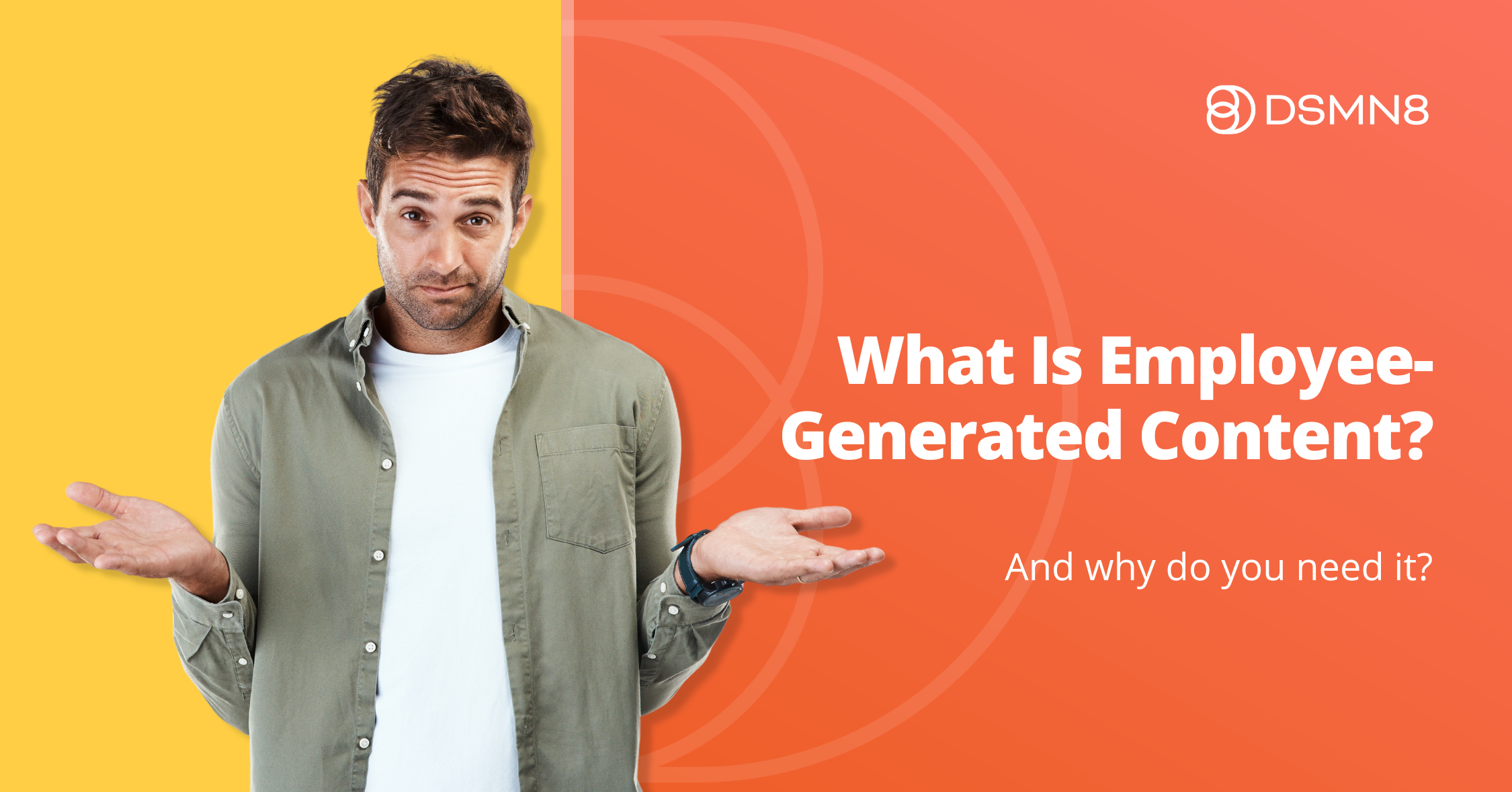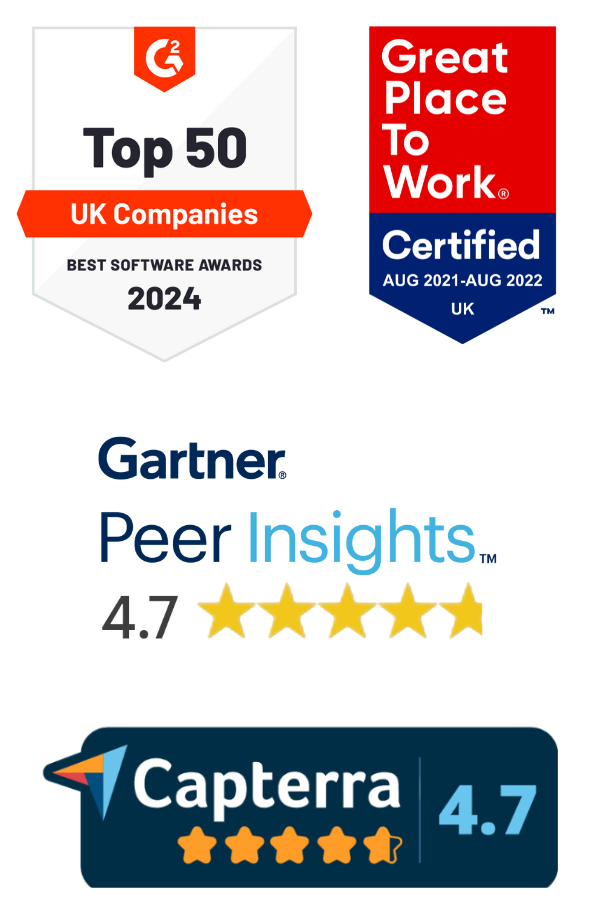
What's on this page:
- What Is Employee-Generated Content?
- Why EGC Matters in 2025.
- Key Benefits of Employee-Generated Content.
- Best Practices for Employee-Generated Content.
- Challenges and Risks of EGC.
- How to Encourage EGC.
- How to Build a Successful EGC Strategy.
- EGC vs UGC vs Traditional Marketing.
- Measuring EGC Success (KPIs).
- How DSMN8 Helps Manage Your EGC.
- Final Thoughts & Additional Resources.
- FAQs.
Last Updated: 19th August 2025.
Employee-Generated Content (EGC) has moved from being a nice-to-have to a strategic imperative. In 2025, trust in traditional corporate messaging is at an all-time low, while peer recommendations and authentic voices dominate decision-making.
EGC harnesses this shift by empowering employees to share their stories, perspectives, and experiences — turning your workforce into a trusted, always-on content engine.
Done well, it drives brand trust, reach, conversions, recruitment, retention, and cost savings.
But to succeed, EGC needs more than encouragement. It requires a strong cultural foundation, clear yet flexible guidelines, employee training, meaningful recognition, and the right technology to scale safely.
This guide covers everything you need to know about EGC: what it is, why it matters, benefits, examples, challenges, best practices, and KPIs.
What is Employee-Generated Content?
Employee-Generated Content (EGC) is any form of content created by your employees, not your marketing team or an agency.
It can be written, visual, or audio, and shared internally or externally.
Examples include:
-
LinkedIn posts from employees about their work or industry.
-
Behind-the-scenes photos or “day in the life” videos.
-
Personal stories, blogs, or podcasts.
-
Professional milestones (promotions, anniversaries, achievements).
-
Sharing company culture, volunteering, or social impact initiatives.
-
Thought leadership insights from leaders and subject matter experts.
💡 Key difference vs User-Generated Content (UGC): UGC comes from customers or the public. EGC comes from employees — the people who know your brand best. That makes it deeper, more credible, and highly trusted.
Why EGC Matters in 2025
In a time where fake news is rife, and seemingly anything and everything can be fabricated, this should come as no surprise.
Consumers are more wary of advertising and marketing tactics, and as a result, trust has shifted:
- 84% of consumers believe that a company’s reputation is influenced by employee personal brands.
-
92% of people trust employees over a company’s corporate messaging.
-
81% say trust impacts purchase decisions, while 88% say authenticity is a key factor.
It’s clear that authenticity is vital for modern buyers.
Our study of half a million LinkedIn posts confirmed the impact EGC can have when it comes to building trust:
-
Personal employee posts generated 9x more engagement than pre-written content.
-
Even minor caption edits tripled engagement vs copy-paste posts.
This makes EGC a strategic lever for:
-
Humanizing your brand: showcasing the people and culture behind the logo.
-
Boosting reach & engagement: employees’ networks are 10x bigger than company pages.
-
Driving conversions: leads from employee shares convert 7x more than other sources.
-
Attracting top talent: 75% of job seekers research an employer’s brand on social media before applying.
-
Improving retention & morale: employees feel valued and connected when their voices are heard.
-
Cutting costs: replacing expensive paid ads or agencies with authentic, in-house advocacy.
Key Benefits of Employee-Generated Content
| Benefit | Why It Matters | Statistics |
|---|---|---|
| Trust & Credibility | Audiences believe employees more than brands | Personal posts = 9x engagement vs curated posts (DSMN8) |
| Reach & Visibility | Employees’ networks are 10x larger than company pages | CEO with 5,000 followers = same engagement as Company Page with 300,000 followers (DSMN8) |
| Conversions | More authentic = more persuasive | Personalised posts deliver 3x more engagement (DSMN8) |
| Recruitment | Showcases authentic culture to candidates | 75% of job seekers check employer brand before applying (LinkedIn) |
| Retention & Engagement | Contributing boosts morale and belonging | Only 0.6% of employees created personal posts — huge untapped potential (DSMN8) |
| Cost Efficiency | Reduces reliance on paid ads & agencies | Average LinkedIn CPC = $5.58. DSMN8 case studies reveal averages much lower than this. |
Best Practices for Employee-Generated Content
- Text-only posts → Generated the highest average engagement (16.5) and clicks (6.36) in our study of 500,000 posts.
- Gallery posts → Multiple image posts, e.g., event and culture recaps, generate the most reactions.
- Personal stories → 9x more engagement than reshared corporate content.
- Professional milestones → Work anniversaries, promotions, or achievements.
- Social impact → Volunteering, sustainability, or charity work.
- Leadership insights → Thought leadership content from execs and SMEs. A CEO can generate the same level of engagement as a company page with 98% fewer followers.
💡 The takeaway: Variety matters. Encourage a mix of personal, cultural, and professional content types to keep your brand narrative authentic, multi-dimensional, and engaging.
Challenges and Risks of EGC
EGC isn’t without its hurdles. Common challenges include:
Brand Consistency – content may vary in tone/quality.
✅ Solve with curated content & examples.
Legal/Compliance Risks – risk of oversharing sensitive info.
✅ Solve with clear guidelines + training.
Employee Hesitation – fear of saying the wrong thing.
✅ Solve with internal comms + leadership participation.
Negative/Off-brand Content – potential missteps.
✅ Solve with review processes & crisis plans.
Rather than avoiding EGC, smart brands manage these risks with clear governance, training, and advocacy platforms.
How to Encourage Employee-Generated Content
Simply asking your employees to create content for you is not enough.
Start by creating a clear set of social media guidelines, and a social media policy. This will alleviate employee fears while ensuring that they understand what they can and can’t say.
For more insights on ensuring quality when it comes to employee-generated content, have a read of our guide.
Follow Bradley Keenan’s Employee-Generated Content Framework:
How to Build a Successful EGC Strategy
Without structure, EGC risks becoming a trickle of one-off posts.
But with the right strategy, it becomes a reliable source of authentic, high-performing content that fuels brand awareness, trust, and recruitment.
EGC vs UGC vs Traditional Marketing
| Factor | EGC | UGC | Traditional Marketing |
|---|---|---|---|
| Source | Employees | Customers/public | Brand/agency |
| Trust Level | Very high | High | Low |
| Reach | 10x company pages | Depends on brand fans | Paid amplification |
| Cost | Low | Low | High |
| Performance | 9x engagement (DSMN8 study) | Product validation | Awareness, but declining trust |
Measuring EGC Success (KPIs)
To prove ROI from employee-created content, track across these five areas:
How DSMN8 Helps Manage and Encourage Employee-Generated Content
To get the most out of employee-generated content, you need more than good intentions. You need a system that makes it easy, engaging, and measurable. That’s where DSMN8 comes in.
With DSMN8, employees can:
-
Submit content ideas for admins to curate and approve.
-
Access fresh, pre-approved posts ready to share to their own networks.
-
Contribute authentic moments — from first-day reflections to team celebrations, behind-the-scenes snaps, or industry insights.
And for admins, it’s all about control and scale:
-
Curate tailored content segmented for the right teams and regions.
-
Ensure posts stay compliant and on-brand.
- Provide a variety of content formats including text, links, images, galleries (multiple images), carousels, and videos.
-
Track performance across engagement, clicks, and conversions.
Why does this matter? Because candidates, customers, and prospects are already checking your brand on social media. The choice is simple: will they see staged stock photography, or a genuine window into life at your company?
Our study of over 500,000 LinkedIn posts proves it: personal employee posts generate 9x more engagement. That’s the kind of impact you unlock when you make EGC part of your marketing strategy.
Instead of pouring budget into agencies or freelancers who can never capture your culture from the inside, consider this: your next superstar content creator is already on your payroll. They just need the right tools to shine.
👉 Ready to explore the platform? Book a Demo.
Final Thoughts & Additional Resources
The data is clear: personal, authentic content outperforms everything else.
Your employees are already your most trusted storytellers. Now it’s time to amplify their voices.
To learn more about creating and sharing authentic content through your employees, sign up for the free Employee Advocacy Certification course.
More content you’ll find helpful:
FAQs
1. What is the difference between employee-generated content and user-generated content?
Employee-generated content (EGC) comes from a company’s internal team, while user-generated content (UGC) is created by customers or the public. EGC is often more brand-aligned and trusted in B2B contexts.
2. Why is employee-generated content effective?
EGC builds trust and authenticity. People are more likely to engage with content shared by real employees than branded corporate messages.
3. How can companies encourage employees to create content?
Companies can provide content, offer incentives, recognize top contributors, and make sharing easy with the help of employee advocacy platforms like DSMN8.
4. Is employee-generated content risky for brand image?
Not if managed well. With clear social media policies, guidance, and optional content approval workflows, EGC can be a powerful and controlled branding tool.
5. What tools can help manage employee-generated content?
Platforms like DSMN8 help companies streamline content creation, sharing, and analytics across teams, ensuring compliance and maximizing reach.
Lewis Gray
Senior Marketing Manager and Employee Advocacy Program Manager at DSMN8. Lewis specialises in content strategy, growing brand visibility and generating inbound leads. His background in Sales lends itself well to demand generation in the B2B niche.





